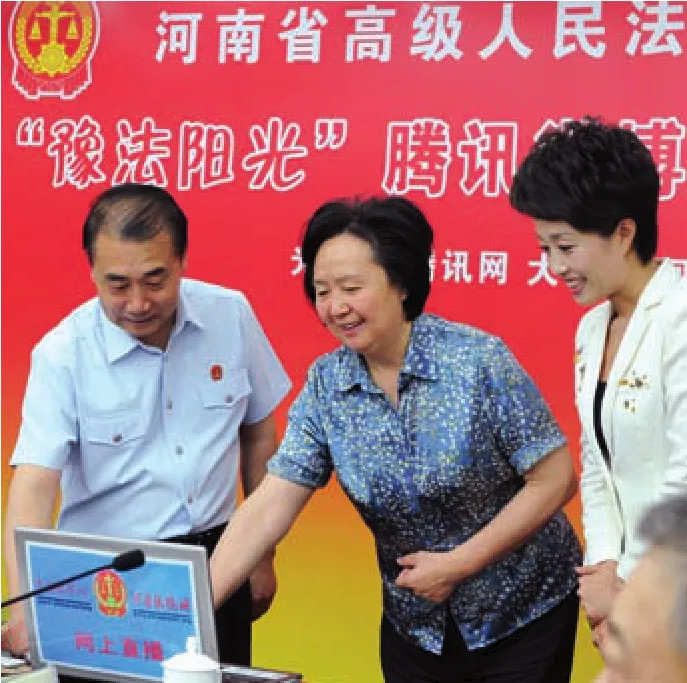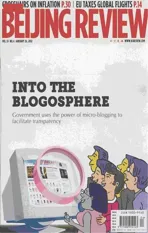JUMPING ON THE ONLINE BANDWAGON
2012-10-14GovernmentagenciesendeavortomakethefastexpandingmicroblogospheremoretransparentByYinPumin
Government agencies endeavor to make the fast expanding micro-blogosphere more transparent By Yin Pumin
COVER STORY
JUMPING ON THE ONLINE BANDWAGON
Government agencies endeavor to make the fast expanding micro-blogosphere more transparent By Yin Pumin
China’s government agencies and officials seem to have been struck by micro-blogging fever.
The number of verified government-run micro-blog accounts on Sina Weibo, China’s leading Twitter-like microblogging service, stood at nearly 20,000 at the end of October 2011, according to a report released by Sina Weibo and the Web portal People.com.cn on December 12, 2011. The fi gure was 5,000 at the beginning of the year.
“If we regard 2010 as the beginning of the micro-blogging boom in China, 2011 can be said to have ushered in the era of government micro-blogging in the country,” said Chen Tong, Editor in Chief of Sina, at the 2011 Government Micro-blogging Summit. In addition to Sina Weibo, Sina also runs China’s largest online news portal.
“These government micro-blogs have enabled direct interaction between government departments, of fi cials and Sina Weibo’s 250 million registered users,” Chen said. “The micro-blog is micro by virtue of its 140-Chinese-character-per-post limit, but it is macro in terms of its impact on public affairs.”
Better interaction
The first official government micro-blog in China was registered by the provincial government of southwest China’s Yunnan Province on Sina Weibo in November 2009, soon after the website went online.
Since then, more and more government agencies and of fi cials have joined the micro-blogging community. The rapid growth of government micro-blogs is in fact changing the whole dynamic of the relationship between the government and the public in China, which has the world’s largest population of Internet users, 500 million, and more than 300 million micro-bloggers.
In a seminar on October 15, 2011, Wang Chen, Minister of the State Internet Information Of fi ce, suggested that government departments and of fi cials use micro-blogs more frequently to release authorized information in a timely manner and step up service-oriented communication with the public.
“The government used to distance itself from ordinary people and usually issued only directives and commands. Ordinary people had little or no chance to have themselves heard by senior officials. But now the government is willing to listen to public complaints and is becoming better at interacting with Internet users,” said Wang Yukai, a professor at the Beijing-based Chinese Academy of Governance (CAG).
On November 28, 2011,the Shanghai Municipal Government launched its micro-blog, called Shanghai City, on Sina Weibo. Within two weeks, the micro-blog,officially verified as originating from the Information Of fi ce of the Shanghai Municipal Government (IOSMG), already had more than 410,000 followers.
In addition to Sina Weibo, the Shanghai Municipal Government also opened accounts on other major Chinese micro-blogging
6,799 websites, and in total they have attracted more than 1 million followers.
The Shanghai City micro-blog covers everything from vegetable prices and weather forecasts to permanent residence registration policies and creative recipes.
“The aim of the Shanghai City micro-blog is to release prompt authoritative government information, provide practical information to local residents, interact with netizens and respond immediately to the most hotly debated social issues,” said Zhu Yonglei, Director of the IOSMG.
According to the IOSMG, more than 600 government agencies and 300 government of fi cials in Shanghai have veri fi ed micro-blog accounts. The of fi cial account of Shanghai’s metro operator, which has more than 1.15 million followers, was fourth on the list of the top 10 government micro-blogs on Sina Weibo in 2011.
Liao Shengqing, Director of the Communication Department at the Shanghaibased Fudan University, attributes the boom to a change in the style of the government’s operation.
“The administration used to follow a strict hierarchy, and everything went from the top down. But nowadays the administration is becoming more flat, indicating that some previous barriers are being removed and messages can spread faster,” he said. “The team working on the Shanghai City micro-blog is,as far as I am concerned, working in the interest of local residents, on which they should keep focusing in the future.”
The Ministry of Foreign Affairs was the first Central Government department to have a micro-blog. Its account“Waijiao Xiaolingtong” (Diplomacy Source)went online in April 2011, and has had nearly 1.25 million followers.
In addition to releasing information about top Chinese leaders’ diplomatic activities and providing contact information to overseas Chinese when emergencies occur, the micro-blog also shares with netizens the experiences of diplomats working abroad and introduces norms of courtesy and good behavior in international dealings such as proper table manners.
“It is hoped that more government departments will join in and open their own official micro-blogs,” said Gong Yufeng, who oversees the micro-blog of the Ministry of Foreign Affairs.
Government micro-blogs have also helped more people, especially residents in economically developed regions, participate in public affairs.
Last year, the government of Nanhai District in Foshan City, south China’s Guangdong Province released real-time information about local elections on its of fi cial micro-blog, in the hopes of putting the whole process under broader public supervision.
“Micro-blogs have played a significant role in improving the government’s decisionmaking process, reducing mistakes and curbing corruption,” said Wang Yukai at the CAG.
Zhu Huaxin, Secretary General of the Department of Public Sentiment Monitoring of People.com.cn, said that government micro-blogs provide a platform that encourages the country’s silent majority to express their opinions, and those concerns can now come to the attention of decision-makers faster than ever before.
“It is a revolutionary change for the country’s officials at every level,” he said.However, he added that of fi cials have a long way to go in terms of creating opportunities for frank, equal and timely exchanges that will allow the administration to take full advantage of the potential of micro-blogs.
Adjusting for demand
Although the number of government microblogs almost quadrupled in 2011, these blogs are not evenly distributed throughout the country, according to the report released by Sina Weibo and People.com.cn.
Economically developed regions, including east, south and north China, have more government micro-blogs than in less developed central and west China.
There are also differences between government departments even in developed regions such as Beijing.
According to Wang Hui, Director of the Information Office of the Beijing Municipal Government, while some local government departments are now used to actively communicating with the public via micro-blogs,many others still follow the traditional method of simply releasing information, which is not timely or interactive.
“On the other hand, some government departments have multiple micro-blog accounts,making it dif fi cult for the public to get a clear overall picture of what the government is doing,” Wang Hui said.
In response, the Beijing Municipal Government launched its news release platform, called Beijing Weibo Press Conference Hall, on Sina Weibo on November 17, 2011.
Twenty-one departments under the Beijing Municipal Government have joined the platform,and six spokespersons from government departments have opened personal accounts.
All the departments involved are required to release their latest policies and regulations through this platform, and Internet users are able to interact with designated spokespersons of the departments to discuss issues that concern them.
“The Beijing Weibo Press Conference Hall is a convenient e-government platform that collates information from many adminis-trative departments and facilitates interaction between of fi cials and the public,” Wang said.

HELPER IN NEED: A member of the Chinese International Search and Rescue Team searches for survivors in quake-hit Ofunato, Japan on March 17, 2011. More than 1.25 million people follow the team on Sina Weibo, China's leading micro-blogging service
Despite the growing popularity of government micro-blogs, Shan Xuegang, Deputy Secretary General of the Department of Public Sentiment Monitoring of People.com.cn., said that government micro-blogs have further room for improvement, especially in their operation, maintenance and style of language.
A major complaint of ordinary microbloggers is that some government microblogs, despite opening to much fanfare, are hardly ever updated, and others simply release bland press releases to the public.
The Beijing Municipal Health Bureau opened its official micro-blog on November 17, 2011, and has had more than 40,000 followers. But it seldom receives feedback from netizens and its posts are rarely forwarded or linked to by other bloggers.
“We are confused about how to interact with netizens and are still looking for ways to operate in this new age of information technology,” said Zhang Jianshu, Director of Information Services at the bureau.
“The government is no longer talking down to the people but interacting with them on an equal basis,” said Zhao Feng, who is in charge of Ping’an Beijing, the micro-blog of the Beijing Municipal Public Security Bureau. The account topped the list of the top 10 government-run micro-blogs on Sina Weibo in 2011.

HOT BLOGGER: Du Shaozhong (center), Deputy Director of the Beijing Municipal Environmental Protection Bureau, is the fi rst government spokesman in Beijing to communicate with the public with a micro-blog

GOING ONLINE: Of fi cials launch the micro-blog of the Higher People's Court of Henan Province on July 7, 2011
According to Zhao, Ping’an Beijing has established a 24-hour micro-blog operation system with 10 of fi cers replying to netizens’questions in shifts. The officers are required to use more everyday language in their posts as micro-blogs are widely considered a faster and more relaxed communication platform.
“We also present some regular features,including information from police labs and crime scenes to make our posts interesting and facilitate interaction between followers and of fi cers,” Zhao said.
In addition, Zhao said that government departments and of fi cials should take a tolerant stance toward dissenting comments on microblogs even if they are critical and sometimes biased. According to him, Ping’an Beijing has never deleted replies since its launch.
In January 2011 Du Shaozhong, Deputy Director of the Beijing Municipal Environmental Protection Bureau, became the fi rst government spokesperson in the city to use a micro-blog to talk directly with the public.
“Public doubts and criticism help government departments improve their work,” Du said, adding that of fi cials should not be afraid of receiving negative comments online.
Trust building
“What to post, when to post, and how to reply to a post are real challenges for government micro-bloggers who represent their of fi ces in the eyes of the public. For example, how to choose the right words to quell public doubt via a 140-character micro-blog when an unexpected accident happens is extremely important and dif fi cult,” said Wang Sixin, a law professor at the Communication University of China (CUC) in Beijing.
However, the government still lags behind in terms of its ability to deal with emergencies on the micro-blogosphere.
“Recent Internet sensations and outcries following major accidents and disasters have highlighted the failure of some government agencies to respond to public concerns online in a timely manner,” said Li Weining, Deputy Director of the Institute of Public Opinion on the Internet at CUC.
For example, a high-speed train crash occurred in Wenzhou, east China’s Zhejiang Province, on July 23, 2011, which left 40 dead and 191 injured. The fi rst report about the crash appeared on Sina Weibo more than two hours earlier than media reports on the Internet, according to of fi cial Xinhua News Agency. In the fi rst 24 hours following the accident, more than 3 million messages were sent on Sina Weibo by eyewitnesses and people who were near the crash site, but no of fi cial statement from the government could be found on the platform.
“Micro-blogs have shortened the principle of responding within the ‘golden 24 hours’ to within an hour after an emergency occurs. Government micro-blogs will inescapably be the focus of the public looking for news on developments after a major public event or emergency,” Li said.
His remarks were echoed by Wu Hui, a professor at the Party School of the Communist Party of China Central Committee. Wu said that the faster the government responds, the higher the possibility that it will win public trust and support, and the chance for misleading rumors to emerge will be reduced.
More importantly, Huang Shengming,a media studies professor also at CUC, said that the authorities should ef fi ciently address and respond to problems and concerns posted by Internet users. He suggested that tangible evidence of responses to public feedback should also be provided on the micro-blogs to assuage public doubts about their ef fi cacy.
However, using micro-blogs alone is not nearly enough for the government to solve its communication problem, said Wang Sixin at CUC.
“More offline work should be done to respond to the feedback the government is receiving and further online communication efforts are necessary,” he said. “The government should also engage in more face-to-face communication with citizens to help address their concerns.”
Government Micro-bloggers
In 2010, government micro-bloggers were mainly opened by departments and of fi cials of public security, tourism,publicity and justice. In 2011, the distribution was more even and covered other fields such as education, culture and sports.
The Beijing Municipal Public Security Bureau, the Chinese International Search and Rescue Team and the Ministry of Foreign Affairs were the top three government microbloggers on Sina Weibo, in terms of both followers and other indicators.
The top 10 government department accounts had 10.3 million followers with a total of 46,000 posts,while the top 10 accounts of individual of fi cials had 10.8 million followers with 44,000 posts.
In addition, the number of veri fi ed accounts of government departments and individual officials on Tencent Weibo, another major micro-blogging service provider in China, exceeded 18,000 at the end of September 2011,with nearly 300 accounts operated by high-level government agencies and senior of fi cials.
